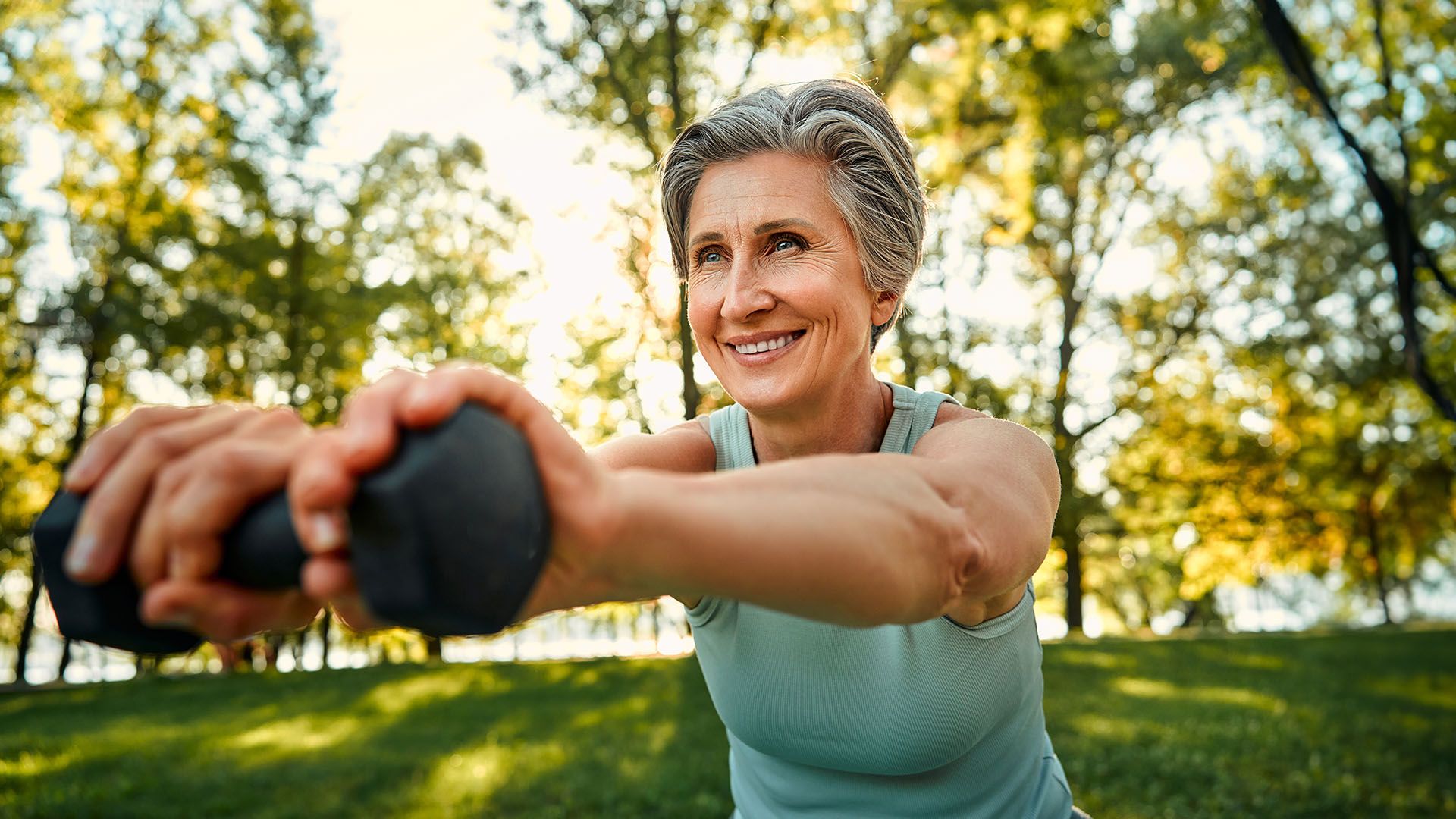Many of us have been taught that the most optimal resistance training method is a “split” routine — meaning you focus on one area of the body on day one, another muscle group on day two, and so forth, until you eventually end with rest and begin the cycle again.
Although split training has its benefits, you can get much more bang for your buck by combining forces — especially when it comes to working your arms and core together.
“The beauty of this type of workout is that it’s accessible and efficient,” leading fitness trainer and DailyOM course creator Lisa Effren tells us. “When you focus on proper form and targeted exercises to effectively stress your muscles, you don’t need hours in the gym to build strength and definition in your arms, shoulders, and core.”
And when you add resistance training — using weights, bands, or body weight — to the mix, Effren says it’s like hitting the turbo button on your fitness journey. Count us in!
Interested in learning more? Check out Weighted Arms and Abs Transformation
Meet Your Teacher: Lisa Effren
For Effren, weight training has always been about more than just physical activity. She became hooked at age 19, when she first discovered that lifting weights doesn’t necessarily have to mean bulking up. Before she became a certified fitness trainer and coach, she drew upon the power of weight lifting to juggle long, arduous workweeks and single parenting. “Training was my stress relief, my source of sanity, and a way to maintain focus amid the chaos,” Effren says. “[Later on] lifting truly became my rock during my four-year battle with AML (leukemia).”
Today, resistance workouts remain Effren’s true north. “Science now confirms what I’ve felt intuitively all along — that muscle mass is key to a long, healthy life. Fitness isn’t about punishment or chasing some unrealistic ideal. It’s about empowering yourself to live a vibrant, active life on your own terms,” she explains.
The Power of Focusing on Your Upper Body and Core in a Single Workout
Combining arm and abdominal workouts with added weights (or body weight) is like magic, Effren says. “It offers a powerful one-two punch for building a strong, functional physique. And overall, it creates a synergy that’s greater than the sum of its parts,” she adds. “You’ll build strength, improve coordination, and enhance your ability to move with ease in your daily life. It’s a win-win.”
It’s important to note that resistance training, whether with weights or body weight, builds muscle mass, which offers science-backed health benefits, including increasing your metabolic rate (which means you can torch more calories even when you’re not actively exercising), along with improving your strength, power, posture, and bone density (to support the natural aging process), among other perks.
Key Things to Know About Working the Arms and Abs Together
- It’s a symbiotic relationship. “Your core actually plays a supporting role in many arm movements,” Effren says. “When you combine them in a workout, your core muscles activate naturally to stabilize your body and ensure proper form. This can even enhance your coordination over time.”
- It supports your everyday life. “Many daily activities, like carrying groceries or lifting objects, require coordination between your arms and core,” Effren says. “By training these muscle groups together, you build strength that translates to real-world functionality.”
- It’s highly efficient. “You can maximize your workout time by targeting two muscle groups at once. This allows you to shorten rest periods between exercises without sacrificing intensity,” she explains.
- Anyone can benefit from it. Plus, you don’t need much equipment (other than hand weights or resistance bands or your own body weight), and these kinds of workouts can be modified to suit all fitness levels and needs. The addition of weights adds variability. “Weights open up a whole new world of exercise options,” Effren says. “You can easily adjust the weight you’re lifting to match your fitness level, making weight training suitable for beginners and experienced exercisers alike.”
Why Tackling an Upper Body and Core Workout Is Easier Than You’d Think
Training your arms and core together is surprisingly achievable, Effren says. “While it may require a little more coordination than isolated exercises, the benefits outweigh the challenge,” she notes.
Even if you have little fitness experience, you can tailor the movements to meet you where you are, Effren adds. “Most exercises can be modified to make them easier to coordinate. For example, you can use lighter weights, focus on slower tempos, or perform exercises on your knees instead of standing,” she explains.
Above all else, this type of workout requires a keen attention to form. “Proper form is key to preventing injury and maximizing results,” Effren says. “Focusing on controlled movements and engaging the correct muscle groups becomes easier with practice.”
The Benefits of Adding a Combined Arms and Core Workout to Your Fitness Routine
Here are some of the health perks you can gain from training your upper body and core in one power-packed workout on a regular basis.
1. It helps you build strength and muscle mass at an accelerated rate
Combining arm and core exercises creates a synergistic effect, Effren says. “Your core muscles naturally stabilize your body during arm movements, allowing you to lift heavier weights or perform more challenging exercises,” she notes. “This translates to faster strength gains in both your arms and core.”
The symbiotic relationship between the arms and abdominals is likely why a study found that core training can benefit golf swing performance. Moreover, one meta-analysis found that core training optimizes the transfer and overall control and force of the limbs in athletes — which implies that they would see more rapid gains.
An even more recent meta-analysis concluded that core training improved variables related to throwing and hitting (which are, of course, related to arm strength).
2. It promotes functional strength to support your daily activities
Many daily tasks — like carrying or lifting heavy objects, doing the dishes, washing your hair, and even driving — require coordination between your arms and core.
“By training these muscle groups together, you build functional strength that translates to everyday activities. You’ll find these tasks become easier and more efficient, reducing the risk of strain or injury,” Effren says.
This is especially so, when you make these kinds of workouts a staple in your routine.
3. It enhances core stability and improves posture
According to Effren, “Strong core muscles provide a foundation for your entire body, promoting good posture and decreasing lower back pain.”
One study found that core-strengthening exercises effectively improve posture and reduce chronic lower back pain.
“This translates to better overall body alignment and reduced risk of injuries,” Effren notes.
4. It increases your metabolic rate to benefit body composition
Muscle tissue burns more calories at rest than adipose (or fat) tissue, Effren notes. “Building muscle mass through arm and core training can lead to an increased basal metabolic rate [BMR], meaning you burn more calories throughout the day, even when you’re not actively exercising,” she explains. “This can help with weight management and overall body composition goals.”
Numerous studies have pointed to this effect, including a study in which researchers looked at the effects of resistance training on a 24-hour period and reported a significant increase in “resting energy expenditure” (meaning energy was being expended between workouts).
In 2022, researchers in a randomized controlled trial confirmed these findings, noting that weight training increased RMR (resting metabolic rate), sedentary energy expenditure, and sleeping metabolic rate in healthy adult males.
5. It boosts your confidence and self-efficacy while reducing anxiety and depression
Witnessing your increasing strength and improved coordination with combined arm and core training can be incredibly empowering, Effren tells us. “This feeling of accomplishment can translate to a confidence boost in all aspects of your life.”
Moreover, a review of randomized, controlled trials found that strength training holds a host of mental health benefits, like lowering anxiety levels in healthy adults, improving sleep quality, reducing depression in depressed adults, and benefiting self-esteem, to boot.
6. It supports healthy aging and longevity
“As we age, muscle loss [sarcopenia] becomes a concern,” Effren shares. “Resistance training is crucial to combat this.
“We spend so much time sitting — at work, watching TV, reading — that without actively engaging our muscles, we’re fighting an uphill battle,” she continues. “Strong arms not only look great, but they also help with daily tasks. And a strong core is the foundation for a healthy, pain-free body.”
A recent review points to the multipronged benefits of resistance training, which researchers found to include treating osteoporosis, osteopenia, sarcopenia, arthritis, and lower back pain.
The Bottom Line
Doing upper body and core workouts together doesn’t just make sense; it also makes your life easier and more efficient. It offers a powerful bang for your buck that’s more beneficial for your body — and your mind — than spending extra time on each area.
Whether you have a demanding schedule, struggle with motivation to work out, or simply want more time to do the things you love, combining arm and core workouts can be a surprisingly simple and easy way to transform the way your upper half looks and feels.

